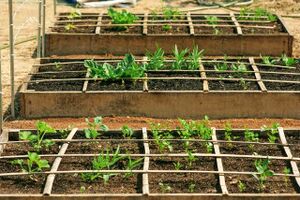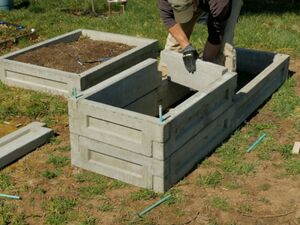Raised garden bed

A raised garden bed is a method of gardening where the soil is elevated higher than the access paths, contained by some material. The enclosure and the soil is referred to as the garden bed. Raised garden beds provide a more ergonomic means of gardening, allow greater control soil and water, reduce soil compaction, control erosion, and extend the growing season. When multiple garden beds are stacked on top of each other, they are generally referred to as a vertical garden.
Raised garden beds can be compatible with the Back to Eden growing method.[1]
Material selection
The beds are often made of wood, rock, brick, or concrete.
Wood, such as pine, is an inexpensive garden wall but has a short life before it decomposes and needs to be replaced. Rot resistance wood, such as cedar, will extend the life of the beds but will cost more and will still eventually decompose. Pressure treated wood should be avoided, especially when growing edible produce, as the chemicals used can leach into the soil and accumulate in the plants.
Concrete masonry unit bricks are an inexpensive option, but should be avoided as they are often made with fly ash.[2]
Dimensions
For comfort and for full access, beds should not be deeper than two feet from the path. If a bed can be accessed from both sides, they are typically four feet. For large areas, efficient garden beds are rectangular with 4 foot depth (or 2 feet depending if it is against a barrier like a fence or building). The length depends on material available and the layout needs. Three feet spacing between beds allow for wheelbarrows. For smaller areas, a keyhole garden shape may be ideal.
Concrete frame
Unlike wood which will decompose, concrete is a long lasting inorganic material that make raised garden bed walls that last indefinitely. Kent Gravelle from MAN about TOOLS created a popular reusable form for casting modular raised garden bed structures that can be made in 24, 36, and 48 inch lengths using Portland or calcium sulfoaluminate cement. Modifications are also available for aircrete or other lightweight alternatives. Video overviews of his technique is shared on his YouTube channel with PDF directions available for purchase from his website.
| Version | Cement | Outside Dimensions | Wall Thickness | Height | Notes |
|---|---|---|---|---|---|
| I | Portland | 36 and 48 inches | 2.5 inch | 8 inches | Uses plywood for straighter connections |
| II | Portland | 24, 36, and 48 inches | 2.5 inch | 8 inches | Easier to construct using dimensional lumber |
| III | CSA | 24, 36, and 48 inches | 1.5 inch | 8 inches | Lighter, stronger, and thinner walls, uses dimensional lumber, but cement cost about 400% more |
Links
- MAN about TOOLS homepage and YouTube channel
- Corrugated galvanized steel raised garden bed - YouTube
- Vertical Garden Bed - YouTube
- Vertical Hydroponics - YouTube
- GreenStalk Vertical Garden - YouTube
